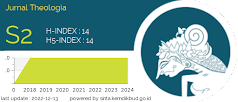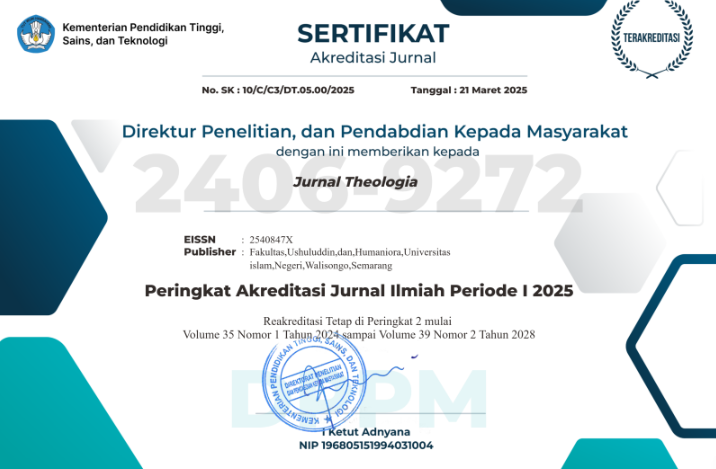NEO-SKEPTISISME MICHAEL COOK DAN NORMAN CALDER TERHADAP HADIS NABI MUHAMMAD
DOI:
https://doi.org/10.21580/teo.2017.28.1.1188Keywords:
neo-skeptisisme, teori the spread of isnād, teori common link, kritik isnād, teori pertumbuhan organikAbstract
Abstract: This writing studies the ideas of renewed skepticism of Michael Cook and of Norman Calder to the prophetic hadith and to the validity of common link theory. By using the method of comparative analysis, it is found that Cook and Calder are highly skeptical to the prophetic hadith and to the validity of common link theory. Cook and Calder's skepticism even exceed Goldziher's and Schacht's skepticism. Cook and Calder say that common link phenomenon did not indicate that a certain hadith is originated from a key or a common transmitter, but it is the result of a different scenario of the spread of isnād and the result of competition of isnād criticism in the schools of Islamic law (madzāhib) in early Islamic society. Both Cook and Calder hesitate the truth and the validity of common link theory. Therefore, according to them, common link method cannot be used to trace the origin, provenance, and authorship of early hadith.
Abstrak: Tulisan ini mengkaji ide-ide neo skeptisisme Michael Cook dan Norman Calder terhadap hadis Muhammad. dan terhadap validitas teori common link. Dengan menggunakan metode analisa komparatif, ditemukan bahwa Cook dan Calder sangat skeptis terhadap hadis Nabi Muhammad. Terhadap validitas teori common link. Skeptisisme Cook dan Calder bahkan melebihi skeptisisme Goldziher dan Schacht. Cook dan Calder berpendapat bahwa fenomena common link tidak menunjukkan bahwa sebuah hadis tertentu itu bersumber dari seorang periwayat kunci atau periwayat bersama, tetapi ia merupakan akibat dari skenario yang berbeda mengenai penyebaran isnād dan akibat dari kompetisi isnād di berbagai aliran fikih Islam (madhāhib) dalam masyarakat Islam awal. Baik Cook dan Calder sama-sama meragukan kebenaran dan validitas teori common link. Oleh karena itu, menurut mereka, metode common link tidak dapat digunakan untuk menelusuri asal mula, sumber dan kepengarangan hadis di masa awal.Downloads
References
Amin, Kamaruddin. "Western Method of Dating vis-a-vis Ulumul Hadits: Refleksi Metodologis atas Diskursus Kesarjanaan Hadits Islam dan Barat." UIN Alaudin Makasar: Pidato Pengukuhan Jabatan Guru Besar, 2010. Makalah belum diterbitkan.
Azami, M.M. Studies in Early Hadith Literature with a Critical Edition of Some Early Texts. Beirut: al-Maktab al-Islami, 1968.
Berg, Herbert, The Development of Exegesis in Early Islam: The Authenticity of Muslim Literature from the Formative Period, Surrey: Curzon Press, 2000.
Calder, Norman, Studies in Early Muslim Jurisprudence, Oxford: Oxford University Press, 1993.
________, Studies in Islamic and Middle Eastern Texts and Traditions in Memory of Norman Calder. by. Norman Calder, Alexander Samely, Jawid Ahmad Mojaddedi, Oxford University Press, 2000.
________, Classical Islam: A Sourcebook of Religious Literature. Routledge, 2003.
________, Interpretation and Jurisprudence in Medieval Islam. Jawid Mojaddedi and Andrew Rippin (eds.), Ashgate Variorum, 2006.
________, Islamic Jurisprudence in the Classical Era. Cambridge: Cambridge Uni¬versity Press, 2010.
Cook, Michael A., Early Muslim Dogma: A Source Critical Study. Cambridge: Cambridge University Press, 1981.
_______. "Eschatology and the Dating of Traditions" dalam Princeton Papers in Near Eastern Studies 1, (1992).
_______. Oposisi Penulisan Hadits di Masa Islam Awal, terj. Ali Masrur. Bandung: Marja Nuansa Cendekia, 2012.
http://en.wikipedia.org/wiki/Michael Cook_%28historian%29.
http://books.google.co.id/books/about/Studies_in_early Muslim_Jurisprudence.html?id=3QT YAAAAMAAJ&redir_esc=y.
http://books.google.co.id/books/about/Studies in Islamic and Middle_Eastern_ Te.html?id= 3RpjAAAAMAAJ&redir_esc=y.
http://books.google.co.id/books/about/Classical Islam.html?id=JdjtUTYSLlUC&redir esc=y.
http://books.google.co.uk/books/about/Islamic Jurisprudence in the Classical E.html?id==2sk BdOJAicOC.
Joseph Schacht, The Origins of Muhammadan Jurisprudence. Oxford: Clarendon Press, 1950.
Jujun S. Suriasumantri, "Penelitian Ilmiah, Kefilsafatan, dan Keagamaan: Mencari Paradigma Kebersamaan, " dalam Mastuhu dan M. Deden Ridwan (ed.), Tradisi Baru Penelitian Agama Islam: Tinjauan antar Disiplin Ilmu, Bandung: Nuansa, 2001.
Juynboll, G.H.A. "Some Isnad-Analytical Methods Illustrated on the Basis of Several Women Demeaning Sayings from Hadith Literature", dalam Al-Qantara. Revista de Etudos Arabes, 10, Fasc. 2, Madrid (1989) dan dalam Beberapa Kajian Indonesia dan Islam, terj. Lilian D. Tedjasudjana. Jakarta: INIS, 1991.
Masrur, Ali, Teori Common link G.H.A Jicynboll: Melacak Akar Kesejarahan Hadits Nabi saw., Yogyakarta: LKiS, 2007.
Motzki, Harald. "The Prophet and the Cat: On Dating Malik Muwatta' and Legal Traditions," dalam JSAI, 22, 1998.





















